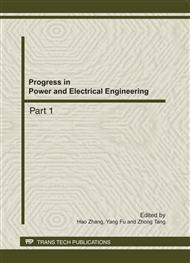[1]
Jingbo Gao, Song Xia. The discussion of the application of the neural network on the online calculation of the thermal stress for turbine rotors[J]. Turbine Technology,1998, 40(5):263-264. In Chinese
Google Scholar
[2]
Xiaoyang Lou, Deren Sheng, Jianhong Chen, et al. Calculation of Finite Element of Thermal Stress and Analysis of Low-cyclic Fatigue Life for Non-central Hole Rotor of 135 MW Turbine[J]. Zhejiang Electric Power ,2007,10(5):10-14. In Chinese
Google Scholar
[3]
Zhiqiang Jiang, Jianhong Chen, Deren Sheng et al. Influence of Simplifying Shaft-Seal Grooves upon Thermal Stress Calculation Result of Steam Turbine's Rotor[J].Thermal Power Generation, 2006, 11(5):11-15. In Chinese
Google Scholar
[4]
Ying Li, Zheng Yun. Life Assessment on HP-IP Rotot of 125MW Turbine[J].East China Electric Power,1999,25(4):7-11. In Chinese
Google Scholar
[5]
Yanjun Shen, Yonghua Yang. The Finite Elements Analysis Approach to the 300MW Turbine Rotor Stress Field[J]. Journal of Zhejiang Ocean University, 1998, 17(3):200-207. In Chinese
Google Scholar
[6]
Jun Liu, Xiaojun Chang, Jian Liu. Pinciple of Neural Network and its applications in Control[J]. Journal of QinDao Institute of chemical technology,1994,(2):167-171. In Chinese
Google Scholar
[7]
SIMON Haykin. Neural Network[M].Wei Shi, JAN Value translation.Machinery Industry Press, 2004.
Google Scholar
[8]
Yuanbing Hou, Jingyi Du, Mei Wang. Neural Network[M]. Xi'an University of Electronic Science and Technology Press,2007. In Chinese
Google Scholar
[9]
Minghua Shen, Li Xiao, Feixing Wang. Application of Support Vector Machine(SVM) in Pattern Recognition[J].Telecommunication Engineering,2006(4):9-12. In Chinese
Google Scholar
[10]
Ailing Ding, Xiaojun Xie, Yi Wen. The Comparison between SVM with Gaussian Kernel and Radial Basis Function Classifier [J]. Computer and Communications,2003(3):44-48. In Chinese
Google Scholar
[11]
Fengling Tao, Zhaonian Li, Jihua Li et al. Application of least squares Support Vector Machine to load forecasting in power system[J]. Water resources nd power,2010(12):146-148. In Chinese
Google Scholar
[12]
Jinyuan Shi, Yu Yang, Zhicheng Deng, et al. On-line calculation method based on artificial neutral network for equivalent stresses in steam turbine rotors[J]. Journal of Power Engineering, 2009, 29(4):316-319. In Chinese
DOI: 10.1007/978-3-540-76694-0_66
Google Scholar
[13]
Feng Pan, Haozhong Cheng, Jingfei Yang et al. Power system short-term load forecasting based on Support Vector Machines[J].Power system technology,2004,29(4):39-42. In Chinese
Google Scholar
[14]
Ning Fang, Dongmei Ji, Xiuping Yao, et al. Model of the stress correction coefficient of steam turbine rotor based on SVR[J]. Journal of Power Engineering, 2010, 30(3):166-169. In Chinese
Google Scholar


